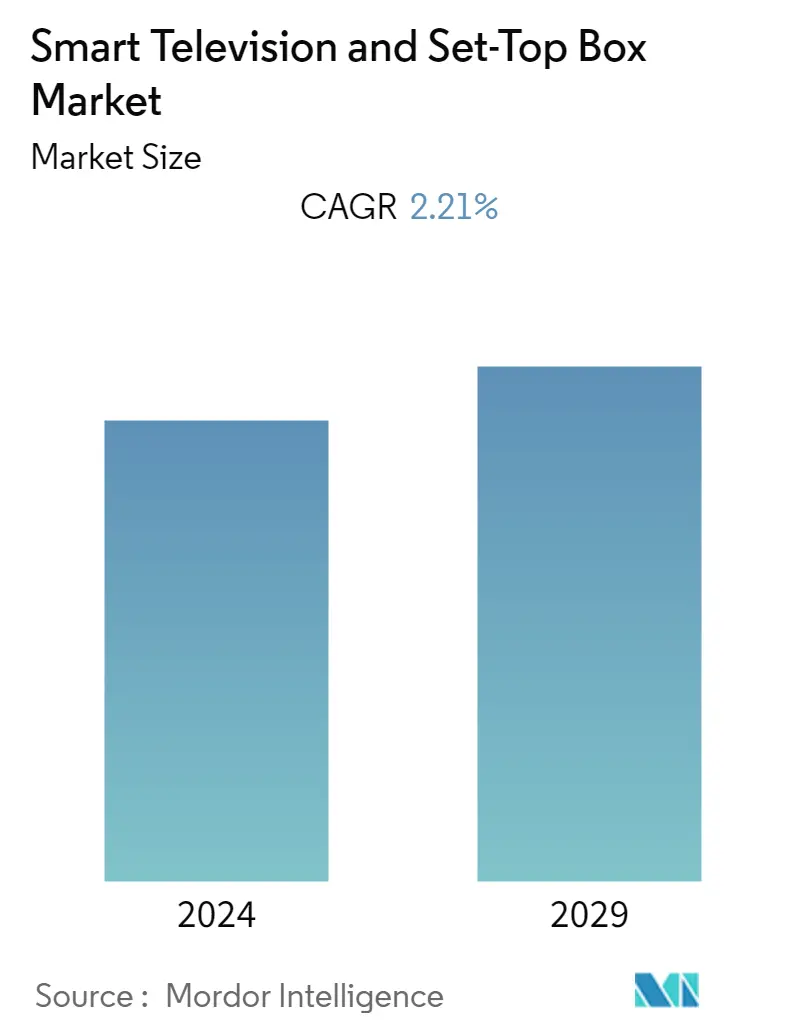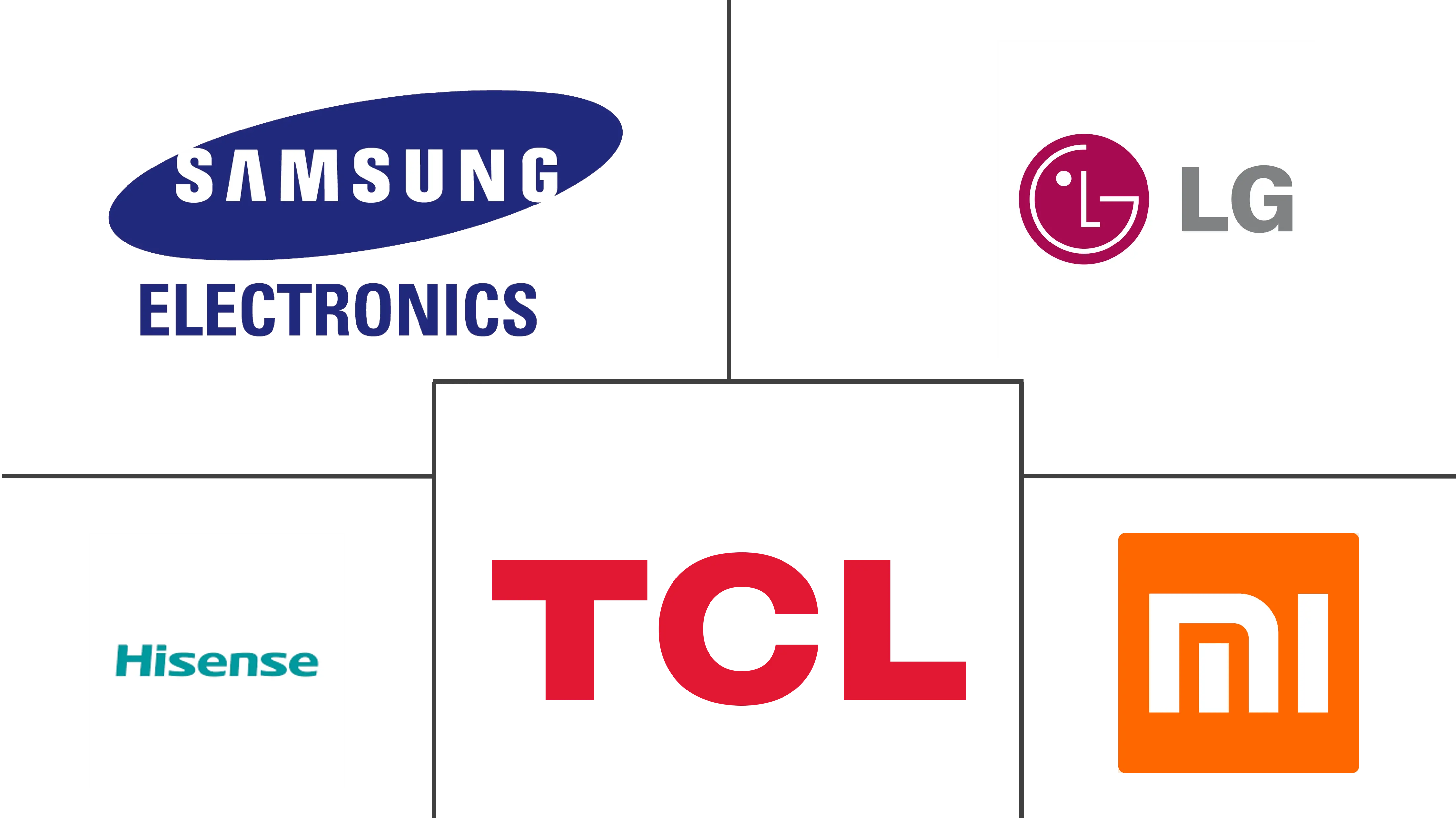Market Size of Smart Television and Set-Top Box Industry

| Study Period | 2019 - 2029 |
| Base Year For Estimation | 2023 |
| CAGR | 2.21 % |
| Fastest Growing Market | Asia-Pacific |
| Largest Market | Asia-Pacific |
| Market Concentration | Low |
Major Players
*Disclaimer: Major Players sorted in no particular order |
Smart Television & Set-Top Box Market Analysis
The Global Smart Television Market was valued at USD 246.56 million in 2021 and is expected to register a CAGR of 2.21% over the forecast period (2022 - 2027).
The Global Set-Top Box Market was valued at USD 226.26 million in 2021 and is expected to register a CAGR of -1.25% over the forecast period (2022 - 2027).
- High levels of technological innovations are driving the growth of the market. The development of a wide range of STBs equipped with various features has made the competition fierce among set-top-box companies. Digital video recording is one of the most desired features, as it enables the viewers to watch and record their favorite shows.
- The deployment of OS-Based devices drives the market growth. The government regulations mandating the installation of set-top boxes, deployment of open OS-based devices by STB vendors, and analog switch-off transition in emerging countries are further driving the demand of the STB market.
- For instance, the Government of India has made STBs compulsory through an amendment to the Cable Television Networks (Regulation) Act. Set-top boxes provide a better viewing experience because of digital signals and help in preventing illegal channels from being broadcasted in India.
- The demand for better picture resolution, in line with the increase in the sales of high-definition TVs, is also pushing the market for set-top boxes that deliver HD and UHD content. However, the Consumer Technology Association (CTA) projected that television shipments in the United States would drop by 8% to 43 million units in 2021, according to its latest "Tech Trends to Watch" research.
- Key players that are significantly active in the Smart TV market include LG Electronics, Samsung, Xiaomi, Vu, TCL, Hisense, and Sony. With the presence of various international brands such as Sony, Samsung, LG, Xiaomi, and many more, the Smart TV market is moderately consolidated, with more than 65% of the market share held by a few prominent companies. These companies are making significant efforts in the Smart TV Markets to create the next big thing by engaging in partnerships and making frequent product developments.
- Further, according to Digital TV Europe Industry Survey 2021, about 35% of the respondents suggested that the set-top is a useful element in the TV operator's proposition but is not irreplaceable, while a further 36% take the view that it is only one option the TV operator must reach customers today and is no more valuable than any other. In addition, 10% of the respondents suggested that the box is central to the TV operator's proposition and is here to stay.
- Market incumbents have been adopting robust competitive strategies involving innovation, partner programs, and market expansion, among others. For instance, Technicolor adopts an operator program focusing on integration benefits to leveraging new operators.
- The COVID-19 outbreak led to lockdowns imposed by the government to curb the spread of the virus, which affected the supply chains of various telecom service providers. In September 2021, the Airtel DTH arm announced plans to stop imports of high-definition set-top boxes by the end of 2021 to tackle the COVID-19-induced supply chain disruption and make locally-developed set-top boxes. Tata Sky, Airtel's major competitor, partnered with Technicolor for the domestic production of set-top boxes in India.
Smart Television & Set-Top Box Industry Segmentation
The scope of the study focuses on the market analysis of Smart TVs and Set-top Boxes across the globe, and market sizing encompasses the revenue generated by these products sold by various market players. The study also tracks the key market parameters, underlying growth influencers, and major vendors operating in the industry, which supports the market estimations and growth rates over the forecast period. The study further analyzes the overall impact of COVID-19 on the ecosystem. The report's scope encompasses market sizing and forecast for technology, Resolution, and geography segmentation for the Set-top box market. The report's scope also encompasses market sizing and forecast for Resolution, Display Size, Technology, and Geography for the Smart TV Market.
| By Technology | |
| Satellite/DTH | |
| IPTV | |
| Cable | |
| Other Types (DTT) |
| By Resolution | |
| SD | |
| HD | |
| Ultra-HD And Higher |
| By Geography | |
| North America | |
| Europe | |
| Asia Pacific | |
| Rest of the World |
Smart Television and Set-Top Box Market Size Summary
The smart television and set-top box market is experiencing dynamic growth driven by technological innovations and increasing consumer demand for enhanced viewing experiences. The smart television segment is characterized by a moderate level of consolidation, with major players like LG Electronics, Samsung, Xiaomi, Vu, TCL, Hisense, and Sony holding significant market shares. These companies are actively engaging in partnerships and product developments to maintain their competitive edge. The set-top box market, on the other hand, is more fragmented, with numerous regional providers and players contributing to its diversity. The deployment of OS-based devices and government regulations mandating set-top box installations are key factors propelling the market forward, particularly in regions like India, where digital signals and improved viewing experiences are prioritized.
The Asia Pacific region is a significant contributor to the growth of both smart televisions and set-top boxes, driven by the rising subscription video-on-demand (SVOD) services and the increasing popularity of large-screen displays. The demand for high-definition and ultra-high-definition content is pushing the set-top box market, while the affordability and accessibility of smart televisions are expanding their reach in markets like India. The integration of artificial intelligence in set-top boxes is enhancing features such as picture and sound quality, further boosting consumer engagement. Collaborations between OTT platforms and set-top box vendors are also on the rise, as seen in partnerships by companies like Vodafone Idea and multi-system operators in the region, indicating a trend towards comprehensive entertainment solutions.
Smart Television and Set-Top Box Market Size - Table of Contents
-
1. MARKET INSIGHTS
-
1.1 Market Overview
-
1.2 Industry Attractiveness - Porter's Five Forces Analysis
-
1.2.1 Threat of New Entrants
-
1.2.2 Bargaining Power of Buyers
-
1.2.3 Bargaining Power of Suppliers
-
1.2.4 Threat of Substitutes
-
1.2.5 Intensity of Competitive Rivalry
-
-
1.3 Industry Value Chain Analysis
-
1.4 Impact of COVID-19 on the Market
-
1.5 Technology Snapshot
-
1.5.1 Evolution of Set-top Boxes
-
1.5.2 Key Collaborations
-
1.5.3 Ongoing Technological Developments
-
-
-
2. SET-TOP BOX MARKET SEGMENTATION
-
2.1 By Technology
-
2.1.1 Satellite/DTH
-
2.1.2 IPTV
-
2.1.3 Cable
-
2.1.4 Other Types (DTT)
-
-
2.2 By Resolution
-
2.2.1 SD
-
2.2.2 HD
-
2.2.3 Ultra-HD And Higher
-
-
2.3 By Geography
-
2.3.1 North America
-
2.3.2 Europe
-
2.3.3 Asia Pacific
-
2.3.4 Rest of the World
-
-
Smart Television and Set-Top Box Market Size FAQs
What is the current Smart Television and Set-Top Box Market size?
The Smart Television and Set-Top Box Market is projected to register a CAGR of 2.21% during the forecast period (2024-2029)
Who are the key players in Smart Television and Set-Top Box Market?
Samsung Electronics Co. Ltd, LG Electronics Inc. , TCL Electronics Holdings Limited , Hisense Group and Xiaomi Corporation are the major companies operating in the Smart Television and Set-Top Box Market.

